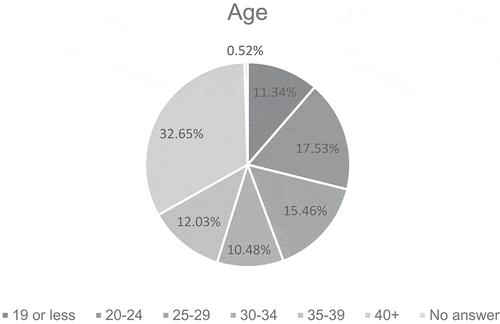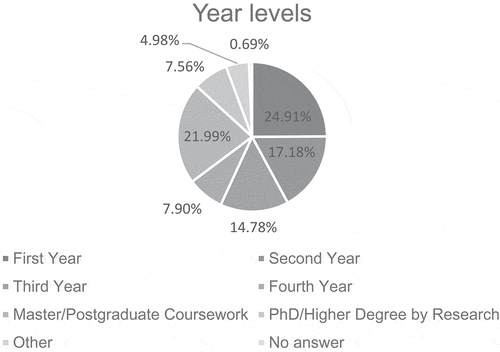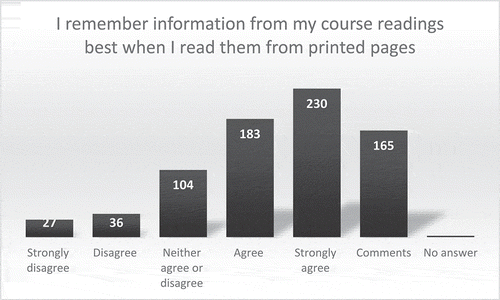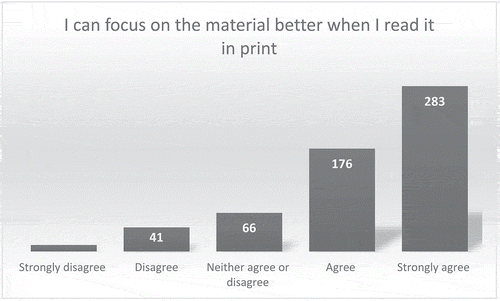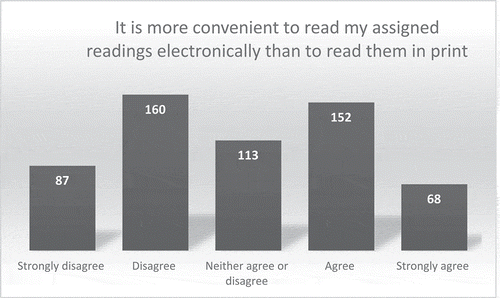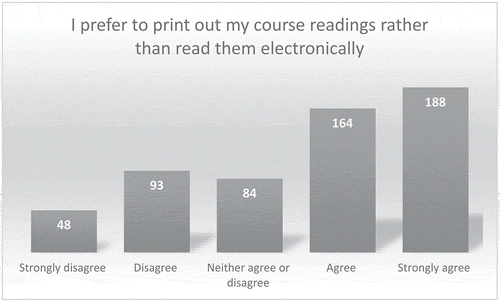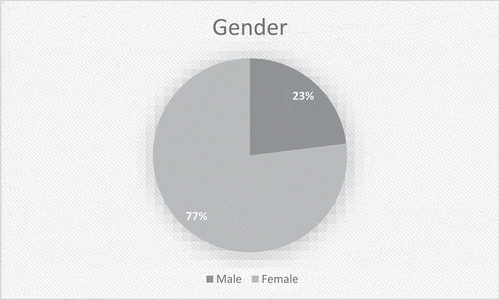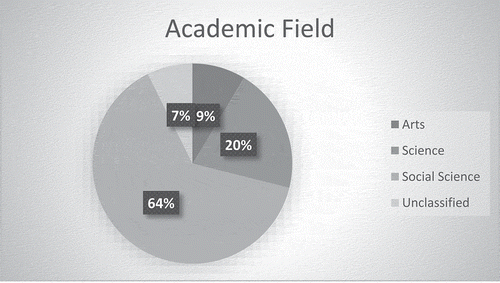ABSTRACT
This paper presents findings from an Australian survey that provides an analysis of the reasons why university students prefer to read print or digital course materials. This survey was undertaken as part of the Academic Reading Format International Study (ARFIS), which is investigating print versus digital reading preferences in 31 countries (Mizrachi et al., 2018). A total of 582 students completed the survey with 471 students providing comments. This article provides an in-depth analysis of the comments from the survey. The comments provided in this survey provide rich data on the reasons why students prefer reading in print or electronic formats, an area of importance due to the increasing prevalence of digital only collections in university libraries. Based on comments, students preferred print due to reasons such as accessibility, eyestrain, tactile features, better focus and ability to highlight and take notes. Although students prefer print, they acknowledge the convenience and cheaper costs of e-texts. Students who were e-preferring were influenced by issues such as cost, environment and convenience. In light of library collections prioritising digital content, tertiary institutions and libraries should carefully consider the role that print textbooks and collections, as well as printing services, may play in supporting student learning.
Introduction
This paper presents findings from an Australian survey that provides an analysis of the reasons why university students prefer print or electronic material at one university. The study involved conducting a survey of the print versus digital preferences of undergraduate and postgraduate students at Edith Cowan University (ECU) in Perth, Australia. ECU serves around 25,000 undergraduate and graduate students across a range of disciplines and has both on and off campus students.
This survey was undertaken as part of the larger Academic Reading Format International Study (ARFIS) that is investigating print versus digital reading preferences in 31 countries. The ARFIS coordinators, Mizrachi, Boustany, and Kurbanoglu slightly modified a survey conducted at UCLA by Mizrachi (Citation2015) and researchers for the ARFIS team were recruited from an existing multinational network to conduct the survey worldwide (Mizrachi et al., Citation2016). The ARFIS questionnaire consists of 17 Likert-style statements on academic reading behaviours and preferences, six demographic questions, and an open prompt for any further information. See Appendix for the ARFIS questionnaire. Questions in the survey aimed to gauge the print and digital reading preferences including whether factors such as length of text and language impacted their preferences. This survey was the only one sent out in Australia and formed part of the overall country results for the larger study. Results included in the study came from a range of countries around the world including Europe, the U.K, the Middle East and Asia. Results of ARFIS so far in 21 countries with over 10,000 students have indicated that most students acknowledge that print works best for learning and still prefer reading their academic texts in print format (Mizrachi et al., Citation2016; Mizrachi, Salaz, Kurbanoglu, Boustany, & Research Team, Citation2018).
This article provides an in-depth qualitative analysis of the comments students provided on their print and digital preferences. The full quantitative results of the Australian survey were reported at the VALA conference (Johnston & Salaz, Citation2018). This paper offers new insights through a qualitative analysis of the comments, which has not been done in the worldwide study. The comments provided in this survey provide rich data on the reasons why students prefer reading in print or electronic formats, an area of importance due to the increasing prevalence of digital only collections in university libraries. University libraries are increasingly following collection development policies with a preference to purchase electronic materials over print materials (Deakin University, Citation2019; University of Queensland, Citation2017), in part due to reasons such as convenience and accessibility of electronic texts. It is, therefore, important to gauge the students’ preferences of print versus digital texts as well as their satisfaction with the usability of e-books and e-readings.
Literature Review
Results of several recent surveys conducted as part of ARFISindicated that most students in all countries that participated feel that print helps them to learn better and prefer reading their academic texts in print format. There were no countries where large differences were found in students’ preferences for print over digital reading (Boustany, Citation2015; Johnston, Salaz, & Alsabbagh, Citation2016; Kortelainen, Citation2015; Zabukovec & Vilar, Citation2015). Farinosi, Lim, and Roll (Citation2016) found no major differences between British, German and Italian students when it came to the practice of reading and writing, although they did find that the adoption of technologies varies between countries and preferences. It is often dependent on factors such as health reasons, for example, headaches from screens; cognitive factors, such as time to process information; aesthetics, such as portability and ecological reasons, such as paper waste. In a study conducted with 400 undergraduate students at the University of California, Mizrachi (Citation2015) found that, overwhelmingly, the students preferred print to electronic formats for learning purposes. The students’ reasons for preferring print included that print caused less eyestrain, the advantages of the tactile aspects of print, and that they were more inclined to highlight and make notes with print readings. Mizrachi also found that multiple factors such as accessibility, cost of textbooks and printing and complexity of the readings had an effect on students’ reading behaviours, such as reading more complex readings in print when they need to employ more deep learning techniques.
Some studies differ in their conclusions from those that found that students prefer reading in print, and have found students self-report a preference for electronic reading. Singer and Alexander (Citation2017) found in their study of 90 university students that the participants expressed a preference for electronic reading for several different types of tasks such as newspaper and magazine reading. The preference for reading in print or electronic formats is often dependent on the complexity or purpose for reading the text and the length of the text. Foasberg (Citation2014) conducted a study with 17 students across all year levels at Queens College, New York where she asked students to record information about their reading practices for 12 days in a diary. She found that students tended to use print for academic and long form reading and to engage with it more deeply, and that students often used the electronic medium for shorter and non-academic reading. Taipale (Citation2014) also found that Finnish students preferred to read short texts on a screen but preferred to read longer texts in print. Farinosi et al. (Citation2016) found that reading screens caused issues of distraction and a lack of concentration, and when texts are long and complex, students print out materials. Another study found the self-reported preference for electronic readings was due to cost as these readings were provided for free and students still felt that there were better able to learn with print materials (Ji, Michaels, & Waterman, Citation2014).
Some studies suggest that reading comprehension in digital or print formats may be impacted on by the level of difficulty of the reading or by the type of device. A study on college students found that the medium might not affect reading comprehension when students are engaged in more simple tasks, but that the medium may have more impact on reading comprehension when it comes to more complex tasks (Subrahmanyam et al., Citation2013). They suggest that students may need to multitask and be strategic about choosing which medium to use when reading for more cognitively challenging tasks. In their systematic review of the literature concerning the impact of the medium on reading comprehension, Singer and Alexander (Citation2017) suggest, based on available empirical evidence, that certain features of e-text, such as scrolling, increase cognitive demands on readers and lower resulting text comprehension. Further, the nature of the reading tasks and type of material interact with the medium to influence both user preference and comprehension. Other researchers have also suggested that differences in reading comprehension seem to be minimised when comparisons are made between paper and e-reader devices rather than computer screens (Clowes, Citation2018).
A study conducted with second-year college students from one university in Beijing, China, found that students who read print texts performed significantly better on the college entrance exam than students reading on computers when it came to shallow level comprehension. They attributed this to reasons such as screen fatigue (Chen, Cheng, Chang, Zheng, & Huang, Citation2014). They also found that familiarity with electronic devices such as tablets resulted in more deep reading comprehension, leading them to conclude that electronic reading comprehension can be improved if you provided training to students on how to use electronic devices. Berg, Hoffmann, and Dawson (Citation2010) also found in their usability study of print and e-books that the undergraduate students in the study appeared to understand the conventions of print books, but were unclear about the functionality of e-books when it came to information retrieval. A study of 91 students at a university found that previous use of e-books did not have an impact on the students’ preference to read in print for learning. The study also found that students were more likely to use special features such as reading captions and charts and answering study questions in print books than in e-books (Woody, Daniel, & Baker, Citation2010). In another study, researchers found that the use of text highlighting during digital reading did not improve comprehension and surmised that digital highlighting might require more cognitive load than print highlighting does, which has been proven to improve comprehension (Ben & Eshet-Alkalai, Citation2018). Liu (Citation2005) outlines how studies have found that annotation and highlighting have not been replicated in digital formats, although there is a preference for using these features when reading print. This is attributed to reasons such as requiring more skills and digital annotation being distracting.
Studies suggest that reading comprehension, both self-reported and through studies of behaviour, is impacted on by the medium of the device that students are reading on. Students self-report that they prefer to read in print as it helps them to learn information, whereas screens may negatively impact on cognitive load and cause strain. The literature provides examples of mostly small scale research projects, therefore, this study addresses the gap of reporting on large scale projects as part of a large international study as well as providing an in depth analysis of the reasons why students prefer to read in print or digital format.
Method
Data Collection
The study involved gathering data from the comments of a survey on the print versus digital preferences of students at one university in Australia. This survey was undertaken as part of the larger Academic Reading Format International Study (ARFIS) that is investigating print versus digital reading preferences in 31 countries. Surveys were sent to all undergraduate and postgraduate students at ECU in April 2017 after receiving ethics approval. The survey was only sent once as permission from the university was only granted to send the survey to students one time. The survey was sent using the Lime survey tool. A total of 582 (2%) students who were sent the survey fully completed the survey. The survey was sent once to all students (24,790) enrolled at ECU. A total of 471 students wrote comments related to their survey answers. The ARFIS questionnaire consists of 17 Likert-style statements on academic reading behaviours and preferences, six demographic questions and an open prompt for any further information. Questions in the survey aimed to gauge the print and digital reading preferences including whether factors such as length of text and language impacted their preferences. Students were able to make comments on each of the 17 questions.
The comments made from the following 13 questions from the original study were analysed in this study. Comments not included in this study were those made on language such as format preference for reading foreign language materials and whether format preference is impacted on by the language of the material, as many students commented that this was not relevant to them in the Australian study.
I remember information from my course readings best when I read them from printed pages
It is more convenient to read my assigned readings electronically than to read them in print
I prefer to have all my course materials in print format (e.g. book, course reader, handouts)
If an assigned reading is 7 pages or more, I prefer to read it in print
I prefer to print out my course readings rather than read them electronically
I like to make digital copies of my printed course materials
I usually highlight and notate my printed course readings
If an assigned reading is less than 7 pages, I prefer to read it electronically
I am more likely to review my course readings (after I’ve read them at least once) when they are in print
I prefer electronic textbooks over print textbooks
I usually highlight and annotate my electronic readings
I can focus on the material better when I read it in print
I prefer to read my course readings electronically
Data Analysis
To categorise the comments into those of e-preferrers and print-preferrers, the respondents’ Likert-style answers across 13 scale items were converted to numerical scores from 1–5. Five of the items were reverse-scored. Opposing statements on a scale of 1–5 were inverted so that ‘1ʹ and ‘5ʹ always mean the same thing. An example of this is: books are better – 5 strongly agree; Ebooks are better – 1 strongly disagree. In this case both the 1 and 5 mean strong print preference. The 5 opposing statements were reverse scored and the 1–5 scale was flipped so that the same number always indicates the same preference.
The respondents’ median scores over the 12-item scale were calculated in SPSS (excluding what was originally item 6). Those with median scale scores of 1, 1.5 or 2 are considered ‘electronic preferring’ (n = 76). Those with scale scores of 2.5, 3 or 3.5 are considered ‘no strong preference either way’ (n = 111). Those with scale sores of 4, 4.5 or 5 are considered ‘print preferring’ (n = 395). This matches the procedure used for analysis in the original study (Mizrachi et al., Citation2018). The scale scores for each participant were then matched to their qualitative comments.
Qualitative comments for each of two groups (e-preferring, print-preferring) were pooled and thematically analysed using NVivo 11. Comments were either deemed relevant to answer the research question and coded, or deemed irrelevant and skipped. An example of a comment deemed irrelevant to the research question ‘Why do print-preferring respondents prefer to read their course materials in print?’ is ‘Always’. Another is ‘I have no words for how much I agree with this. There is no comparison.’ These comments emphasise the original response but is not explanatory or related to answering the question of why. While previous literature suggests reasons driving format preferences, themes from this data were generated inductively without the application of a previously conceived code or taxonomy, in order to allow for the introduction of new ideas or lines of reasoning beyond what has been seen in previous study groups.
Results
Demographics
The majority of students who completed the survey were female. 443 (76%) of the respondents were female, with 134 (23%) of respondents being male. Two (1%) of the respondents identified as other. As shown in : Age, the largest age group to respond was students aged 40+ with 190 (33%) responses, followed by the 20–24 age group, 102 (17%), closely followed by the 25–29 age group with 90 (15%) responses. The other three age groups all averaged around the same number of responses averaging between 10–12% of the responses. A range of different year levels responded to the survey. As shown in : Year levels, the biggest group of students to reply to the survey were first years with 145 (25%) respondents followed by Masters students with 128 (22%) responses, with the third largest group to respond being second year students with 100 (17%) responses. Students were also asked what major they were studying and in what mode they were studying. The answers for the major the students were studying was categorised into three subject areas. The majority of the respondents were studying a social Sciences major with 370 (64%) responses, followed by Science with 118 (20%) of the responses and Arts with 50 (9%) of the responses. 44 (7%) students left this answer blank. The majority of students who responded to the survey were on campus students with 343 (58%) of the responses followed by off campus students with 145 (24%) responses and finally 107 (18%) were mixed mode.
Of the 582 students who fully completed the survey, 471 wrote comments related to their survey answers. The following results show how many students were print or e-preferring and the reasons why they preferred print or electronic formats for reading. The results also show that although students prefer print, students still acknowledge the convenience of electronic formats. The results also provide an analysis of the comments to reveal why print-preferrers don’t highlight, annotate or save digital texts. Statistical analysis was also conducted on the comments in order to make conclusions as to whether age, gender or academic discipline had any bearing on preference.
Preference for Print
As shown in , 413 (71%) of the students agreed or strongly agreed that they remember information from their course readings best when they read them from printed pages. Students also consistently agreed that they could focus better on the material when they read it in print.
As shown in , 459 (79%) of students felt they could focus better on materials when they are in print.
: Reasons for preferring print
Table 1. shows the top explanations given for preferring print reading by the 395 print-preferring participants.
Respondents described how print materials provide an opportunity to write in the margins, underline or highlight important information, and allow them to easily refer back to or refer across notes and readings. This activity is often linked to a sense of improved comprehension and memory. The following quotes show examples of how the students felt print texts afford easy highlighting, notetaking, bookmarking and saving.
‘Being able to interact with the printed page help with my learning process – with the printed material I can highlight and annotate on the sides to help’.
‘When printed, I can highlight key points and make notes on the page which helps me to remember information’.
‘I like to highlight the notes to refer back to. I can then annotate in my own words that allows me to understand the information on a personal level’
‘I like to highlight words/sentences. Write notes, underline words/sentences’.
‘Being able to annotate on the page helps connect the information to my brain’.
‘Being able to bookmark easily with a book as well as underline/highlight. I feel like reading off a screen limits my interaction with text’.
‘It is much easier to hold a page with your finger and skim back or forward through the document as required; rather than scrolling’.
‘Hard copy makes a much better record and library materials – e-copies are ephemeral, get lost more easily, end up as clutter that takes an inordinate amount of energy to catalogue and maintain’.
Respondents also explained that print sources are always available, while electronic sources require devices, charge/power, Wi-Fi connectivity and loading times. Respondents described print resources as being instantly accessible, portable and not requiring special knowhow. The following quotes show examples of why students felt that print texts are accessible.
‘Having printed material means I don’t have to get online or risk not being able to access something online, and I can sit wherever I want when I am reading printed material’.
‘Sometimes technology fails and the internet can be unreliable’
‘Within a few years, software and hardware change so much that old e-records can’t be read/accessed’
‘I print out ALL my readings – its expensive – but I feel more confident having the readings as hard copies so I can take the readings with me and its easily accessible’.
‘Print is much more convenient for me as I do not have any access to digital sources and I can take and read a print source anywhere as long as I have it on hand’.
Respondents stated that print copies help acquire an overview of the material, and to know ‘where they are’ in a text. Respondents describe difficulties absorbing information while screen reading. They reported being less distracted, remembering more, and comprehending or absorbing more information from print. The following quotes show examples of why students felt that print texts support comprehension, memory and learning.
‘I find the information doesn’t go in when I read it from a screen’
‘I like to know “where I am” in the document and I find this easier with a printed copy’
‘I find it more difficult to concentrate & retain information when reading from electronic devices’.
‘The loss of productivity, primarily due to increased distractibility, of digital readings, leaves me with a strong preference for print media’.
‘I’ve found I notice and remember information I’m learning when I associate it with silly things like a smudge or coffee stain on the page. Online readings tend to look pretty similar’.
Participants also stated that they prefer print because electronic reading causes eye-strain, back pain, headaches, and loss of sleep and that respondents appreciate the tangible, tactile nature of hard copy and in some cases link it to comprehension and memory. The following quotes show examples of why students felt that print texts are more ergonomic and afford a tactile experience.
‘I get tired quickly with digital formats’.
‘I’m a mum of an 18 month old. So reading my coursework after he goes to bed in essential. Working with the blue light after hours impacts on my sleep’.
‘Too much time staring at computer screens give me eye strain and a headache’.
‘Senses are more alert and memory retention is better….physical contact perhaps enhances my reflexes’.
‘It takes a different energy to continually read information from your computer, it is more relaxing reading printed pages you can hold them and quickly go back and forth, there is also something psychological better about turning pages than scrolling and clicking the computer’.
‘Sometime being able to play with a page between your fingers is stimulating whilst you concentrate on other things’.
‘Nothing beats the texture of physically turning the pages of a book’.
Preference for electronic
Students were asked if it is more convenient to read their assigned readings electronically rather than in print. As shown in , students were fairly evenly split as to whether they found it more convenient to read assignment readings electronically or in print. 247 (42%) of the students disagreed or strongly disagreed that it was more convenient to read assigned readings electronically, with 220 (38%) agreeing or strongly agreeing that it is more convenient to read assigned reading electronically. As shown in : Printing out course readings, 352 (60%) of students agreed or strongly agreed that they prefer to print out their course materials rather than read them electronically.
: Reasons for preferring e-reading
Table 2. shows the top explanations given for preferring e-reading by the 76 e-preferring participants.
Respondents described how e-texts are conveniently accessible from anywhere, anytime and are less likely to be lost or damaged. Some respondents study online and find it inconvenient to travel to a library or bookstore for physical materials. Respondents also describe the weight and physical labour involved with carrying hard copy books around, especially when commuting by bike or public transit, as well as the clutter and storage involved with printed paper. Respondents also appreciated the ease of searching for and within electronic materials, and the ease of duplicating sections or full-text of materials for notes and organisation. The following quotes show examples of why students felt that e-texts are more convenient and accessible.
‘Much easier to read whenever wherever as most the time you either have a tablet/laptop/smartphone with you’.
‘It is much easier in terms of portability to use my iPad (electronic device) than a book, especially if the book is bulky. I also find it difficult to ‘word search’ through hardcopy when compared to electronic copy’.
‘This makes my IPad my one stop shop for learning, and are portable, I can learn in more places’.
‘I am an online student so I don’t have access to the printed books in the library. Online reading is very important to me’.
‘I prefer reading from the computer, saves paper and space, is with me wherever I need to access it, easy to find information with Ctrl+F no point with printed paper now-days’.
Respondents prefer e-texts to reduce textbook and course material costs, and avoid printing articles because the cost of paper prints is also expensive. Respondents also believed that using digital readings and avoiding printing paper is healthier for the environment, reduces waste and saves trees. It could be speculated that this is an important issue in Australia where many people are environmentally conscious. The following quotes show examples of why students felt that e-texts are more cost effective and environmentally friendly.
‘The cost of purchasing textbooks per subject per semester is quite hefty. Electronic books are a great support to my studies’.
‘It’s cheaper, better for the environment and there’s less clutter too’.
‘It is more convenient and cheaper to read electronically’
‘This is based on the cost of buying text books vs reading the electronic versions available from the library – more financially convenient’.
‘It is more convenient and cheaper to read electronically’.
Convenience versus Preference
Throughout the comments, print-preferrers acknowledge some of the same benefits of e-texts identified by the e-preferrers, particularly cost advantages, but still prefer print. Many describe the conflict of preferring print but not wanting to or being able to pay for it. 40 students made comments that reflect the view that e-texts are cheaper and/or more convenient, but they still prefer print. The following comments reflect this view:
‘I do prefer printed copies. Unfortunately, the costs of buying printed copies can be an obstacle’.
‘I like ease of access to electronic but feel I learn better from print’
‘[I have] a strong preference for print media. I rarely purchase physical textbooks despite the previous statement, unaffordability being the primary impediment’.
‘Print is best by far for study but digital is sometimes necessary for convenience’.
‘I cannot afford to print out my readings if they are not printed out already’.
;The cost of printing them out is a consideration but I much prefer printed readings if I can afford it’.
‘However a lot I don’t [print] because the cost would be prohibitive. I read them online and find that my notes and ability to retain the information is compromised come test/exam time’.
‘This is my preference and I find it easier to learn this way but sometimes for convenience/economical reasons it is necessary to read digital’.
‘If I am using an electronic textbook it is because I can’t afford to buy the actual book but I don’t like them’.
‘They are so cumbersome to use and you have to scroll back and forth to glimpse figures and tables – URGGH! Give me print anyday! (just charge me online book prices!)’.
‘I enjoy the convenience of being able to access reading materials online when at uni, rather than carrying heavy textbooks. However, when given the option at home, I prefer to read from hard copy textbook’.
Why Don’t Print-Preferrers Highlight, Annotate or Save Digital Texts?
The most prevalent theme among print-preferrers commenting on their preferences was that print materials afford a chance to write on, highlight, mark, annotate, underline, fold, dogear, bookmark, organise and otherwise manipulate and interact with the text in ways that enhance learning. However, many of us will recognise that e-reading platforms, devices and software today do, in fact, offer a plethora of features that enable such behaviors while reading. So why don’t print-preferrers use them?
19 respondents felt that this was because of poor usability with participants describing how features for engaging with e-text such as highlighting and annotating are cumbersome, slow, not uniform, and difficult to find and refer back to. The following quotes show examples of why students felt that e-texts were not user friendly.
‘This can be a pain depending on the file format and device used’.
‘too cumbersome to do so. (It might be different if I was prepared to pay for an app to turn PDFs into Word docs, but I object to paying Adobe.)’
‘I personally find apps for editing readings difficult’.
‘Its too time consuming, its quicker highlighting and writing on printed readings’.
‘It seems way more annoying and more steps required than using my own hand’.
The other reason students stated they did not use the digital features of e-texts was that they do not know how. 19 respondents described not knowing how to use the text engagement features afforded by e-reading platforms, though several indicate a desire to learn. The following quotes show statements from students about their lack of knowledge of e-text features.
‘I am not as computer literate in order to carry this task out’.
‘Don’t know how to. (Would like to know how to.)’
‘I wouldn’t even know how to do this electronically’!
‘Not IT savvy enough’
‘Embarrassingly I don’t know how to’!
Statistical Analysis
Full group analysis has been conducted using non-parametric statistical tests (Mann-Whitney U and Kruskal-Wallis H) for examining the distribution of responses across the ordinal scale by group.
For categorical independence examining the relationship between nominal categories of variables such as gender and preference group membership (e-preferrers or print preferrers), chi-squared has not been applied or reported for the whole group because of the sensitivity of chi-squared tests to sample size. Instead, a random subsample of 282 participants was taken using SPSS, and chi-squared reported for this sample. Across the random subsample, participants were categorised as print-preferrers, e-preferrers or ‘neutral’ based on their overall median scale scores as described in ‘Procedures’, above. This categorization is the respondent ‘Preference group’.
Gender
As shown in : Gender, 77% of participants were female and 23% were male.
TOTAL GROUP (n = 581)
Male n = 134 (23%)
Female n = 447 (77%)
Mann-Whitney U analysis of the response distribution: U = 39,999.5, Z = 6.123, p < .005, r = 0.254.
AMONG E-PREFERRERS (n = 76):
Male n = 36 (47.37%)
Female n = 40 (52.63%)
ASSOCIATION BETWEEN GENDER AND FORMAT PREFERENCE GROUP:
Chi-Square = 13.179, df = 2, p < .001, n = 282, Phi = .216.
These variables are related with a small-to-medium effect size.
Typical response bias has more females volunteering to respond to the survey; among e-preferrers, males are overrepresented, making up nearly half of the e-preferring group while constituting under a quarter of the total cohort. The non-parametric Mann-Whitney U analysis yields an effect size estimate of 0.254 for this preference difference by gender, an overall small-to-medium effect.
Age
As shown in : Age, there was a fairly even distribution across age groups with the highest number of participants in the 40+ age group.
TOTAL GROUP (n = 581):
19 or less n = 66 (11.3%)
20–24 n = 102 (17.5%)
25–29 n-90 (15.5%)
30–34 n = 61 (10.5%)
35–39 n = 70 (12%)
40 + n = 190 (32.6%)
Kruskal-Wallis analysis of response distribution by age indicates no association between age and format preference
AMONG E-PREFERRERS (n = 76)
19 or less n = 9 (11.8%)
20–24 n = 11 (14.5%)
25–29 n-12 (15.8%)
30–34 n = 12 (15.8%)
35–39 n = 7 (9.2%)
40 + n = 25 (32.9%)
ASSOCIATION BETWEEN AGE AND FORMAT PREFERENCE GROUP:
Chi-Square = 9.3, df = 12, p < .677, n = 282
These variables are INDEPENDENT and unrelated.
The age distribution among e-preferrers is remarkably similar to the overall group age distribution. Those 40 and above make up 32.6% of the total group, and 32.9% of the e-preferrers. Those 19 or less make up 11.3% of the total group, and 11.8% of the e-preferrers. In this sample, the age of a person has no impact on format preferences.
Academic Field
As shown in : Academic field, the largest number of participants came from social sciences with 64%, followed by Science at 20%.
No difference in format preference response distribution whether arts, science, social science, or unaffiliated among the whole group.
TOTAL GROUP (n = 581)
Arts n = 50 (8.6%)
Science n = 118 (20.3%)
Social Science n = 371 (63.7%)
Unclassified n = 43 (7.4%)
AMONG E-PREFERRERS (n = 76):
Arts n = 3 (3.9%)
Science n = 16 (21.1%)
Social Science n = 52 (68.4%)
Unclassified n = 5 (6.6%)
ASSOCIATION BETWEEN ACADEMIC FIELD AND PREFERENCE GROUP:
Chi-Square = 10.426, df = 6, p < .108, n = 282
These variables are INDEPENDENT and unrelated.
Discussion
The findings of the Australian survey were consistent with the overall statistical findings for all countries that participated in the ARFIS study, with 70–80% of students agreeing that they prefer to read in print and feel it helps them to learn more effectively (Mizrachi et al., Citation2018).
Students preferred print due to reasons such as accessibility, eyestrain, tactile features, better focus and ability to highlight and take notes and electronic for reasons such as portability and the environment. This confirms other studies that have found that portability, health, cognitive, aesthetics and environmental reasons impact on students’ preference for print or digital formats (Farinosi et al., Citation2016; Mizrachi, Citation2015). It also confirms other studies that have found that students do not take notes and highlight in digital formats and this can often be due to usability and cognitive/skill level when using digital features (Ben & Eshet-Alkalai, Citation2018; Liu, Citation2005). Print-preferrers frequently comment on the learning, information retention and comprehension benefits that they perceive with print texts. They often stated that reading in digital format causes eye strain and headaches which impacts on retention and memory and that there are psychological reasons such as relaxation and sensations that physical contact with print reading is better for retention and memory. Farinosi et al. (Citation2016) also found that health and cognitive factors impact on the use of technology in students. The common themes surrounding print include that it improves ‘comprehension, memory and learning’ and allows students to easily ‘highlight, note take, bookmark and save’, and how print enables students to have a ‘tactile experience’, where text engagement and physical engagement are often viewed as intermediating factors to better learning and comprehension.
Students also had concerns about the functionality and reliability of technology and felt reading electronically does not help them retain information and can be distracting. Farinosi (Citation2016) also found that students found that paper has many advantages when it comes to portability and that there is no risk of not be able to read due to technological reasons such as a lack of power. The concerns about being less able to access e-texts than print texts somewhat runs against the prevailing concept of the ‘anytime, anywhere’ characteristic of digital content. This may be indicative of some respondents feeling the effects of the well-known ‘digital divide’ – without high-speed, reliable internet access, fast and updated devices and software, e-reading is likely to be a slower, more tedious process.
Research also supports students’ self-reported statements that reading electronically does not help them learn or retain information and that reading electronically is better suited to more surface leaning or for simple tasks (Subrahmanyam et al., Citation2013).
Students still acknowledge the convenience and cost of e-texts, especially those students studying online. Comments from the students indicated that the availability of textbooks in the library greatly impacted on students’ reading behaviours and choices. Online students found it very important to be able to access electronic course readings and textbooks through the library, as they do not have the choice to come to campus. Similar to findings by Ji et al. (Citation2014) cost also had an important part to play in students’ reading decisions. Students noted their preference is to read in print, but their decision to read electronically is a financial decision and that, if the e-reading or e-textbooks were available in the library, they would read this version. Several students noted that they would like more access to electronic textbooks as, although they prefer print, there often were not enough copies in the library.
These competing concerns, of comfort, readability, usability and perceived learning and focus, versus the costs and convenience of e-formats, demonstrate that neither format is superior in all contexts. Clearly, there are task and material types for which electronic texts are ‘good enough’ or better than print, and this is typically associated with speed of access, portability and cost. Prior evidence suggests that these circumstances would generally be associated with less demanding learning situations and tasks, as well as shorter reading materials, whereas tasks which require deeper learning or more sustained focus as with lengthier texts, would lend themselves to print (Singer & Alexander, Citation2017). This research has implications for libraries as students often make reading choices based on the availability of texts in the library and the cost of textbooks (which are cheaper electronically). Students self-report that they print out electronic readings so that they can read in print, and even though they acknowledge the convenience of electronic resources, they still prefer to read in print as it helps them learn and does not cause cognitive load and strain. Discussions around ideas such as implementing hybrid models for collections and lower printing costs are important for libraries to meet the reading preferences of students.
Conclusions
This research studies the self-reported reading preferences of university students in Australia, engaged in reading academic course material either in print or digital formats. Students in this study overwhelming have a preference for reading in print and this raises questions about continuing trends in university libraries to have electronic only collections. Although the convenience of providing electronic resources is invaluable to students, especially those studying online, reading on screens comes at the expense of students’ reading comprehension when it comes to deep learning tasks, and has negative physical impacts as well as many issues when it comes to usability. Because electronic/digital collections are seen as convenient but not user friendly, university libraries can play a role in shifting students’ preferences towards digital readings through providing training in how to more effectively use e-platforms as well as lobbying publishers to develop more user-friendly features and platforms. In light of library collections prioritising digital content, tertiary institutions and libraries should carefully consider the role that print textbooks and collections, as well as printing services, may play in supporting student learning.
One indication for further research comes from the association between reported learning engagement behaviours and medium preferences. Students in this study report not using notetaking, highlighting or saving digital texts often due to issues of usability or lack of awareness of how to use the features. Determining whether format preferences can be influenced by manipulating the amount of training and experience on digital learning engagement tools that participants are exposed to will be important to explore further. Another area for future research is to explore if training in using the features of digital resources would improve usability satisfaction in digital learning features. There is no evidence in this sample that age or academic discipline have an impact on format preferences. However, there is evidence that gender may have some kind of relationship to format preference, and the nature of that relationship is currently unclear and requires further investigation. There are many avenues for future research stemming from the results of this worldwide study and immediate implications for library practice arising from these findings.
Disclosure statement
No potential conflict of interest was reported by the authors.
Additional information
Notes on contributors
Nicole Johnston
Dr Nicole Johnston is the Associate University Librarian for Digital and Information Literacy at Edith Cowan University (ECU), Perth, Australia. She is also a Lecturer for the School of Science at ECU.
A.M. Salaz
Dr A.M. Salaz is the Associate Dean for Research and Academic Services at Carnegie Mellon University in Pittsburg, PA, USA and an analyst for the Academic Reading Format International Study (ARFIS)
References
- Ben, Y. G., & Eshet-Alkalai, Y. (2018). The contribution of text-highlighting to comprehension: Acomparison of print and digital reading. Journal of Educational Multimedia and Hypermedia, 27(2), 153–178.
- Berg, S. A., Hoffmann, K., & Dawson, D. (2010). Not on the same page: Undergraduates’ information retrieval in electronic and print books. The Journal of Academic Librarianship, 36(6), 518–525.
- Boustany, J. (2015). Print vs. electronic: What do French students prefer in their academic reading material? Paper presented at the Third European Conference on Information Literacy (ECIL) October 19-22, 2015, Tallinn, Estonia.
- Chen, G., Cheng, W., Chang, T.-W., Zheng, X., & Huang, R. (2014). A comparison of reading comprehension across paper, computer screens, and tablets: Does tablet familiarity matter? Journal of Computers in Education, 1(2–3), 213–225.
- Clowes, R. W. (2018). Screen reading and the creation of new cognitive ecologies. AI & Society(1), 1–16. doi:10.1007/s00146-017-0785-5.
- Deakin University. (2019). Collection development. Retrieved from https://www.deakin.edu.au/library/about/collection-guidelines/colldev
- Farinosi, M., Lim, C., & Roll, J. (2016). Book or screen, pen or keyboard? A cross-cultural sociological analysis of writing and reading habits basing on Germany, Italy and the UK. Telematics and Informatics, 33(2), 410–421.
- Foasberg, N. M. (2014). Student reading practices in print and electronic media. College & Research Libraries, 75(5), 705–723.
- Ji, S. W., Michaels, S., & Waterman, D. (2014). Print vs. electronic readings in college courses: Cost-efficiency and perceived learning. The Internet and Higher Education, 21, 17–24.
- Johnston, N., Salaz, A., & Alsabbagh, L. (2016). Print and digital reading preferences and behaviors of University students in Qatar. In Kurbanoğlu S. et al. (Eds.), Information literacy: key to an inclusive society. ECIL 2016. communications in computer and information science (Vol. 676). Springer, Cham..
- Johnston, N., & Salaz, A. M. (2018). Print versus digital preferences of university students in Australia. Paper presented at the VALA conference, Melbourne, Australia.. https://www.vala.org.au/vala2018-proceedings/vala2018-session-13-johnston/
- Kortelainen, T. (2015). Reading format preferences of finnish university students. In S. Kurbanoğlu, J. Boustany, S. Špiranec, E. Grassian, D. Mizrachi, & L. Roy (Eds.), Information Literacy: Moving Toward Sustainability: Third European Conference, ECIL 2015, Tallinn, Estonia, October 19- 22,2015, Revised Selected Papers (pp. 446–454). Cham: Springer International Publishing.
- Liu, Z. (2005). Reading behavior in the digital environment: Changes in reading behavior over the past ten years. Journal of Documentation, 61(6), 700–712.
- Mizrachi, D. (2015). Undergraduates’ academic reading format preferences and behaviours. The Journal of Academic Librarianship, 41(3), 301–311.
- Mizrachi, D., Boustany, J., Kurbanoğlu, S., Doğan, G., Todorova, T., & Vilar, P. (2016). The Academic Reading Format International Study (ARFIS): Investigating students around the world. In: Kurbanoğlu S. et al. (Eds), Information literacy: Key to an inclusive society. ECIL 2016. Communications in computer and information science, (Vol. 676). Springer, Cham.
- Mizrachi, D., Salaz, A., Kurbanoglu, S., Boustany, J., & Research Team, A. R. F. I. S. (2018). Academic reading format preferences and behaviors among university students worldwide: A comparative survey analysis. PloS one, 13(5), e0197444.
- Singer, L. M., & Alexander, P. A. (2017). Reading across mediums: Effects of reading digital and print texts on comprehension and calibration. The Journal of Experimental Education, 85(1), 155–172.
- Subrahmanyam, K., Michikyan, M., Clemmons, C., Carrillo, R., Uhls, Y. T., & Greenfield, P. M. (2013). Learning from paper, learning from screens: Impact of screen reading and multitasking conditions on reading and writing among college students. International Journal of Cyber Behavior, Psychology and Learning (IJCBPL), 3(4), 1–27.
- Taipale, S. (2014). The affordances of reading/writing on paper and digitally in Finland. Telematics and Informatics, 31(4), 532–542.
- University of Queensland. (2017). Collection management policy Retrieved from https://web.library.uq.edu.au/collections/collection-management/collection-management-policy
- Woody, W. D., Daniel, D. B., & Baker, C. A. (2010). E-books or textbooks: Students prefer textbooks. Computers & Education, 55(3), 945–948.
- Zabukovec, V., & Vilar, P. (2015). Paper or electronic: preferences of slovenian students. In S. Kurbanoğlu, J. Boustany, S. Špiranec, E. Grassian, D. Mizrachi, & L. Roy (Eds.), Information Literacy: Moving Toward Sustainability: Third European Conference, ECIL 2015, Tallinn, Estonia, October 19- 22,2015, Revised Selected Papers (pp. 427–435). Cham: Springer International Publishing.
Appendix
ARFIS questionnaire
Format Preference
– I remember information from my course readings best when I read them from printed pages.
strongly agree, agree, neither agree or disagree, disagree and strongly disagree
– It is more convenient to read my assigned readings electronically than to read them in print.
strongly agree, agree, neither agree or disagree, disagree and strongly disagree
– I prefer to have all my course materials in print format.
strongly agree, agree, neither agree or disagree, disagree and strongly disagree
– If an assigned reading is 7 pages or more, I prefer to read it in print.
strongly agree, agree, neither agree or disagree, disagree and strongly disagree
– If an assigned reading is less than 7 pages, I prefer to read it electronically.
strongly agree, agree, neither agree or disagree, disagree and strongly disagree
– I prefer electronic textbooks over print textbooks.
strongly agree, agree, neither agree or disagree, disagree and strongly disagree
– I can focus on the material better when I read it in print.
strongly agree, agree, neither agree or disagree, disagree and strongly disagree
– I prefer to read my course readings electronically.
strongly agree, agree, neither agree or disagree, disagree and strongly disagree
Learning Engagement (self-reported behaviours)
– I usually highlight and notate my printed course readings
strongly agree, agree, neither agree or disagree, disagree and strongly disagree
– I usually highlight and annotate my electronic readings.
strongly agree, agree, neither agree or disagree, disagree and strongly disagree
– I am more likely to review my course readings (after I’ve read them at least once) when they are in print.
strongly agree, agree, neither agree or disagree, disagree and strongly disagree
– I prefer to print out my course readings rather than read them electronically.
strongly agree, agree, neither agree or disagree, disagree and strongly disagree
– I like to make digital copies of my printed course materials.
strongly agree, agree, neither agree or disagree, disagree and strongly disagree
Language
– I prefer to read course readings which are in my native language electronically rather than print.
strongly agree, agree, neither agree or disagree, disagree and strongly disagree
– I prefer reading foreign language material in print rather than electronic format.
strongly agree, agree, neither agree or disagree, disagree and strongly disagree
– My preferred reading format, electronic or print, depends on the language of the reading.
strongly agree, agree, neither agree or disagree, disagree and strongly disagree
– I read my electronic course readings on a: (desktop computer, laptop computer, iPad/Tablet, dedicated E-reading (e.g. Kindle), Phone, with an Audio Application, I never read course material electronically, other)

